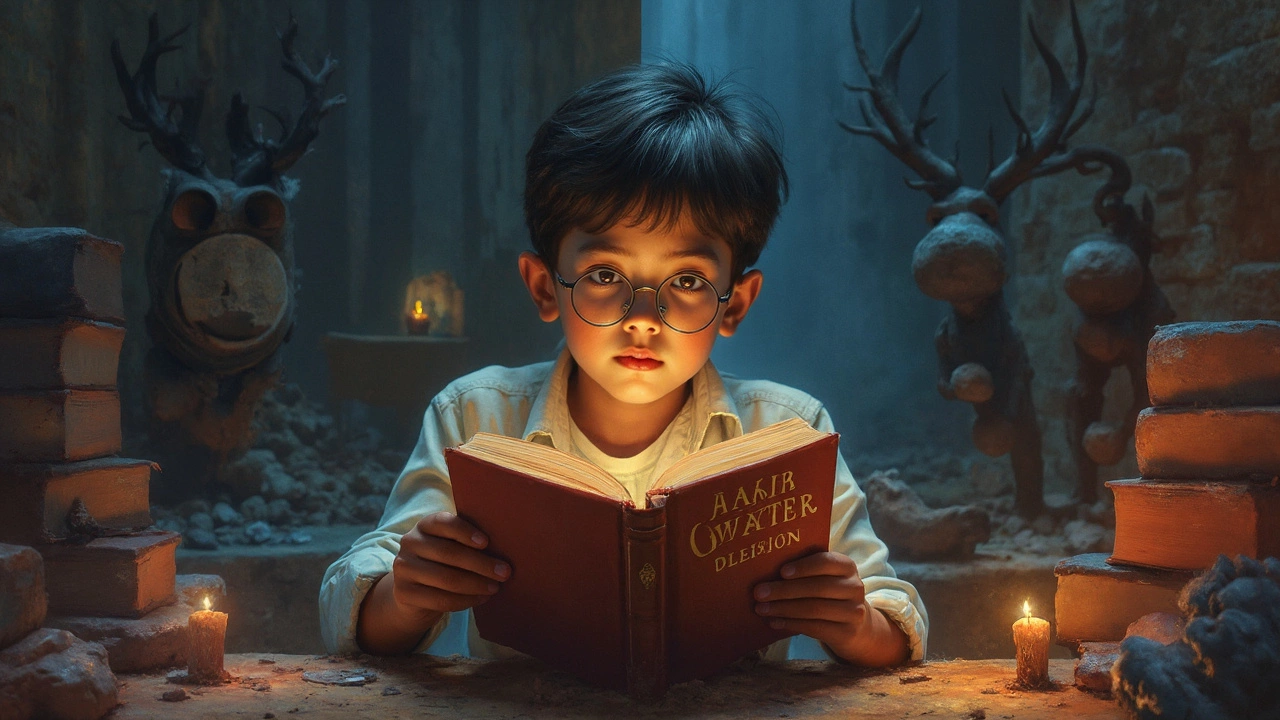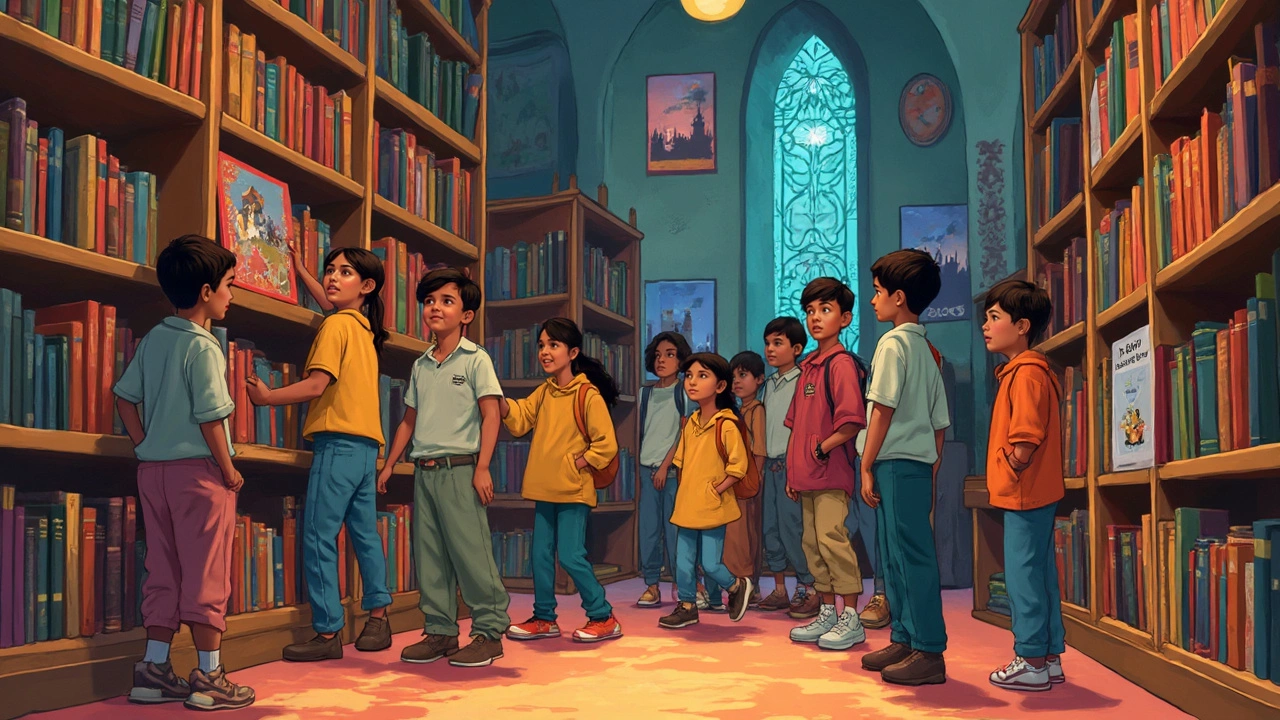Ever noticed that Harry Potter never quite fits in one neat box? Ask a librarian or a bookseller and you'll probably get a shrug—or maybe even a passionate rant. People can't seem to agree: Is Harry Potter meant for kids, teens, or both?
This actually matters more than you might think. When parents or teachers pick books, they want to know if they're choosing something that's safe, exciting, or too mature. The age question isn't just trivia; it helps families decide what to hand a nine-year-old versus a thirteen-year-old.
Right away, there’s a clue in the way the books change as you go. The first one's pretty friendly for younger readers, but by the time Harry faces Voldemort for real, things get way darker. That jump in themes and danger is why the argument never really gets settled.
- What Makes Something a Children's or YA Book?
- The Harry Potter Series: How Age Fits In
- Themes, Darkness, and Growing Up with Harry
- How Bookstores, Libraries, and Readers Decide
What Makes Something a Children's or YA Book?
There’s more to this question than just how old the hero is. Publishers, teachers, and librarians usually sort books into Children’s or YA based on a mix of stuff: the age of the main character, how tough the themes get, how complicated the writing style feels, and what kinds of problems the story tackles.
Children’s books often focus on characters under twelve, family, friendship, and learning right from wrong. They use straightforward language and keep the danger and darkness dialed down. For example, heroes might get scared, but you won’t see them dealing with death, betrayal, or serious trauma in a detailed way.
YA (Young Adult) books, on the other hand, usually star teens, often exploring things like identity, romance, peer pressure, or even tough stuff like loss and mental health. These stories don’t talk down to readers. The style gets more layered, and the stakes feel higher—think about facing a bully versus fighting for your life or watching a family fall apart.
- Children’s Books: Ages 7-12, simple language, clear morals, gentle topics.
- YA Fiction: Ages 12-18, deeper themes, emotional growth, riskier choices and sometimes darker events.
Rarely is any book strictly “kids” or “YA,” but this is the basic rundown librarians use. Here’s how the main differences break down:
| Category | Main Character's Age | Themes | Style |
|---|---|---|---|
| Children's | 7-12 | Friendship, Family, School | Simple |
| YA | 12-18 | Identity, Romance, Complex Issues | More Advanced |
Here’s the twist for something like Harry Potter: the books start off looking like children’s fantasy and finish out dealing with topics and dangers more common in YA fiction. That sliding scale is part of what keeps people arguing about where it belongs.
The Harry Potter Series: How Age Fits In
If you line up all seven Harry Potter books, the vibe shifts a lot from start to finish. The first book, Harry Potter and the Sorcerer’s Stone, was written for ages eight to twelve. That’s the sweet spot for middle grade readers—kids who are old enough to handle magic and mystery, but not quite ready for the heavy stuff.
J.K. Rowling actually planned the series so Harry would grow up with the readers. Each book covers another year at Hogwarts, and the problems Harry faces get more intense. By book three or four, you start to feel the story lean into teen territory, dealing with loss, fear, and tough choices—stuff that’s more common in YA fiction.
Check out the ages for the main releases:
| Book | Recommended Age |
|---|---|
| Philosopher’s Stone | 8-12 |
| Chamber of Secrets | 8-12 |
| Prisoner of Azkaban | 9-13 |
| Goblet of Fire | 10-14 |
| Order of the Phoenix | 11-15 |
| Half-Blood Prince | 12-16 |
| Deathly Hallows | 13-17 |
So, what does that mean for where it belongs? The younger books really nail the classic children’s adventure. The later ones turn up the danger, the moral struggles, and even the romance—touching classic YA spots. A lot of fans pick up the first book as kids and finish the last one as teens, right in sync with how Harry, Hermione, and Ron are growing up.
This jump isn’t an accident. Rowling has said before she wanted readers to grow with the story, not just be stuck with books that never get any deeper. That’s how you end up with a series that sits in between shelves, appealing to both gradeschoolers and full-blown teenagers.

Themes, Darkness, and Growing Up with Harry
What really sets Harry Potter apart is how the tone and topics shift as the series goes on. When you look at the first book, the worries are pretty innocent: secret letters, learning spells, and going on midnight adventures. The dangers are there—think of the encounter with Voldemort at the end—but they're wrapped in puzzles and fun. Younger kids can handle these stories without problem.
But starting with Book 4, “Goblet of Fire,” things take a sharp turn. The death of Cedric Diggory is a shock, and suddenly, readers are hit with grief, betrayal, and the idea that some things don’t have happy endings. By “Order of the Phoenix” and “Half-Blood Prince,” there’s no avoiding tough stuff like trauma, loss, and even big topics like death and prejudice. That’s a big leap from the light-hearted start.
J.K. Rowling once said she never set out to write only for children—she just wanted to tell a story that grew with her characters. That’s exactly what happens. Harry’s problems in the last books—ranging from dealing with an awful government to feeling alone—are a lot like the tough moments teens go through in real life.
Check this out — a published survey in 2017 asked readers when they started the series and what age they’d recommend for each book. Here’s the rough spread:
| Book | Recommended Starting Age |
|---|---|
| Sorcerer's Stone | 8+ |
| Chamber of Secrets | 9+ |
| Prisoner of Azkaban | 10+ |
| Goblet of Fire | 12+ |
| Order of the Phoenix | 13+ |
| Half-Blood Prince | 14+ |
| Deathly Hallows | 15+ |
So, what does this mean for families or readers picking up the series? If you start young, you’ll notice the books “grow up” with you. That’s a big reason why so many people say the series starts as a children's book but ends as young adult fiction. You can adjust your pace or wait a bit before jumping into the darker stuff, especially with younger kids.
The cool thing? Harry’s maturing journey lets everyone—from kids to adults—find something to connect with, no matter where they jump in.
How Bookstores, Libraries, and Readers Decide
In the real world, how do places actually pick where to shelve Harry Potter? It’s a mix of tradition, age guidelines, and what seems to click with local readers. Walk into a big bookstore chain like Barnes & Noble, and you’ll spot Harry Potter in the children’s section most of the time, right next to books for ages 8 to 12. Sometimes, they double-dip and stock the series in the young adult aisle too. It’s not just laziness—publishers officially market the first three books for middle grade but aim the later books at older readers.
Libraries do something similar. The American Library Association actually lists the first four books as children’s fiction, but by Order of the Phoenix, you’ll often see the series popping up on both children’s and teen shelves. According to Karen Jensen, a librarian and YA expert,
“Libraries go with where the most readers are, and with Harry Potter, that’s both kids and teens. Sometimes we even put copies in both sections.”
This split can confuse readers and parents. Here’s what usually drives the decision:
- Audience age: The early books are easy reads for eight-year-olds, but by the fifth one, the language and themes suggest 12 and up.
- Cover art: In the UK, they printed special “adult” covers so grown-ups wouldn’t feel weird reading them on public transport. Marketing really affects shelf placement!
- Reader demand: If lots of teens check the books out, libraries add them to YA shelves too.
- School reading lists: Harry Potter is often on middle school syllabi, but high schools use the later books for deeper discussions about trauma, loss, and identity.
Here’s a little snapshot showing where you might find the series in actual stores and libraries:
| Location | Shelf Placement |
|---|---|
| Barnes & Noble (US) | Children's & YA |
| Waterstones (UK) | Young Readers & YA |
| Public Libraries | Children's & Teen/YA |
| Scholastic Book Fairs | Children's (main) |
At the end of the day, readers themselves are the wild card. Plenty of adults obsess over the books too and don’t care where they’re shelved. The Harry Potter label wears many hats, and bookstores, libraries, and fans seem cool with that. The shelf it’s on just gives you a clue about where its journey begins—not where it ends.

